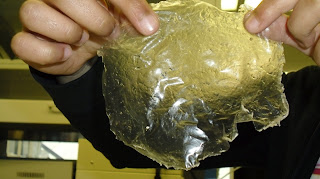Initial Tensile Test
Another test for the polymer films was the puncture test. For this test, another device was designed using plastic forks, tape, and styrofoam. As seen in the image below, a flat piece of styrofoam was pierced by the heads of two forks, and duct tape was used to secure the forks. To conduct the test, the circular film specimen would be taped flat across the rim of a beaker. Then, the fork tips would be put in contact with the film, and pennies would be gradually added to the styrofoam piece until the film was punctured. Again, this test proved to be unsuccessful due to the inconsistencies in the amount of pressure placed upon the films from the 8 different fork tips. Also, the device would need to be stabilized using the hands, which further degraded the accuracy of the test. As a result, proper testing equipment was sought in order to conduct the test in a more accurate and consistent way.
Puncture Test Device
Despite the challenges in conducting the tensile and puncture test, other tests were still successfully conducted. A flexibility test was conducted on the films by wrapping the test specimens around a uniform cylindrical pen with a diameter of 0.635 centimeters. This test was essential in order to determine if the materials were flexible enough to function as a garbage bag. Nearly all of the specimens were able to be wrapped around the pen without any cracks, rips, or other damage. The only specimen that failed the test was the 70% starch film. This film visibly cracked while being wrapped around the pen. This was due to the high starch content in the film without the presence of additional plasticizers. Even before the flexibility test, the 70% starch film clearly demonstrated poorer quality than the other test specimens due to cracks in the surface, stiffness, and inability to form a uniform film.
The last test that was conducted during week 7 was the biodegradability test. Each of the test specimens was cut into a small piece and submerged separately into small vials filled with water. The vials were placed in an oven at 40 degrees Celsius in order to provide a uniform temperature for the degradation test. After 3 days, the test specimens would be removed from the oven and observed to determine the level of biodegradability that each film exhibited.
The last test that was conducted during week 7 was the biodegradability test. Each of the test specimens was cut into a small piece and submerged separately into small vials filled with water. The vials were placed in an oven at 40 degrees Celsius in order to provide a uniform temperature for the degradation test. After 3 days, the test specimens would be removed from the oven and observed to determine the level of biodegradability that each film exhibited.
Initial Images of Biodegradability Tests:
Starch Film from Trial #3:
60% Starch Composite Films - Highest Starch Concentration for Successful Films:











No comments:
Post a Comment